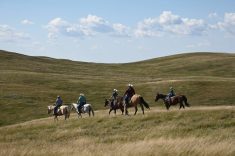Three years ago the Canadian Veterinary Medical Association along with several industry partners came up with a Therapeutic Decision Cascade for Animal and Public Safety (a decision tree).
This is a great tool for reminding all veterinarians and producers how to properly select drugs for any species we are treating. This guide is an valuable reminder of which medications are approved for each species. How and what we do to treat our farm animals and pets ultimately could affect us humans down the road.
We are fortunate in the cattle industry to have many products approved for use. To be approved means a product has a known withdrawal time for meat and milk (if used in dairy cattle). They also come with a DIN or drug identification number. It would be very rare indeed for a large-animal veterinarian to use products not approved for use on bovines, and if they did it would be done under a written prescription.
Read Also

Harvest wraps up and fall work begins
At the Eppich famly ranch in western Saskatchewan, the fall harvest was successful with few breakdowns, cows and calves have been sorted and a new tractor has arrived
We need to use antibiotic products prudently. That means we only use Category 1 drugs such as Baytril, Excede or Excenel for treatment, and for specific conditions at that.
As veterinarians we also need to do more cultures and sensitivity tests on behalf of our clients to determine which antimicrobial is in fact the best for a particular condition such as respiratory disease. This means we may initiate treatment first and then change antibiotics if cultures show a better choice.
Many more prescriptions are written for minor species such as sheep and goats as these products have not been fully researched in these species. Primarily this is necessary because the amount of sales of products with these species would not justify the regulatory or research cost to put them on the label.
Your veterinarian must use their past experience and shared knowledge to determine which product is safe and effective. We call this extra-label usage. It covers approved products for other species and/or products given in a different route or with a higher dosage than indicated. Your veterinarian will use the best resources at hand such as CgFARAD, which is a national food safety database, that can give recommendations on extra-label usage for withdrawals and safety.
Safety first
Technical services veterinarians are also approached by the various pharma companies for their expertise on the products they handle. We need to consider safety because as veterinarians we first “do no harm”a and secondly do not create residues in meat and milk.
The third category in this cascade involves using an approved human drug in veterinary medicine. Although this is very rare in cattle practice, it is more common in equine or small animal practice. Again this is done by prescription and only after veterinary-approved drugs are first considered. This usually occurs when a culture test shows certain infections have proven resistant to veterinary drugs.
The last three categories are what we call compounded drugs. One group is made from other veterinary-approved drugs for, say a different method of administration. The others are drugs compounded from human drugs.
The most critical, and probably overused and over-abused medicines, are drugs made from the raw products. These are called active pharmaceutical ingredients (API) and are imported as raw product from other countries. There is not near the control on their manufacture, so CgFARAD cannot comment on their safety. These products should be used only as a last resort.
In production animal beef practice we have the ability most times to stick with an approved product. Most new products are approved for cattle when licensed. Producers and veterinarians should only use the API category as a last resort. A prescription is always needed. Having access to API products is actually a loophole in our import regulations the government should try and close. These products have no DIN in this country and the potential for abuse and exceeding drug withdrawals is massive.
The provincial veterinary associations could start possibly creating a document for best-use practices for extra-label usage on these minor species that can serve as a very good guide to your herd’s veterinary practitioner.
The approved veterinary drugs fall into four categories themselves ranging from Category 1 being those of high importance in human medicine to Category 4 such as the ionophores, which have low importance in human medicine. Most of the antimicrobials used in production animal medicine are Categories 4, 3 and 2.
Excellent reference material
Alberta Beef Producers has produced an excellent brochure that beautifully illustrates the various categories with several examples. It also discusses other things the cattle industry is doing to tackle this antimicrobial resistance issue.
One pharmaceutical company has a chart listing the common antibiotics in each category, which is great to hang on your wall. Watch for it. This printed material will be useful if you want to ever explain antibiotic resistance as it relates to animals to your urban family, friends or neighbours.
Remember, when considering a product follow the decision tree it’s veterinary first, then human and finally API products, in that order. We in the cattle industry are in a position to be leaders for the other species because we have so many products approved for use. Stay away from the Category 1 products as much as possible.
Talk to your vet about for the best advice. Lets all think and use all the knowledge we know to select the best antimicrobial for the job bearing in mind this decision tree. Health Canada has information detailing the drugs in each category on its website.














